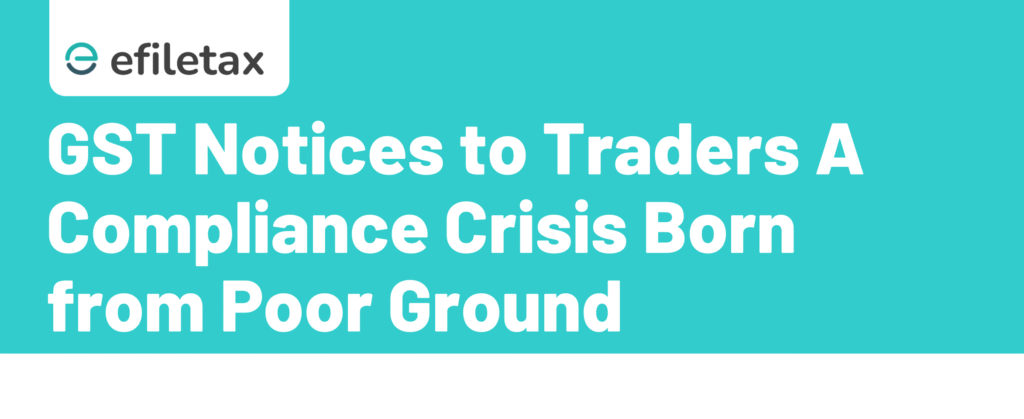
Summary
GST notices to traders have triggered panic across markets. Poor data matching, hasty actions, and lack of field-level coordination have led to a compliance fiasco that was avoidable with better ground engagement and tech integration.
Introduction
GST notices to traders across India have sparked confusion and backlash, especially from small and medium businesses. Within the first 50 words, it’s clear this is more than just a routine compliance drive — it reveals a deeper disconnect between policy intent and implementation. With lakhs of traders receiving show-cause notices for mismatches or technical lapses, questions are being raised on fairness and clarity in GST enforcement.
Why are Traders Getting GST Notices?
According to CBIC and state GST authorities, most notices are being issued for:
- Mismatch in GSTR-3B and GSTR-1 filings
- Ineligible ITC claims under Section 16 of CGST Act
- Non-filing or delayed filing of returns
- Suspicious high turnover jump flagged by AI/analytics
But many traders claim:
- Returns were filed but not auto-reflected
- ITC was claimed based on vendor invoices
- Notices were auto-generated without verification
Legal Angle: What the Law Says
- Section 61 of CGST Act allows scrutiny of returns.
- Rule 99 of CGST Rules governs issuance of Form ASMT-10 (scrutiny notice).
- Show-cause notices (SCNs) under Section 73 or 74 may follow for recovery.
- CBIC Instruction No. 02/2022-GST requires risk-based selection and human vetting before scrutiny.
⚠️ But field officers often bypass vetting, issuing bulk notices based on software alerts — leading to wrongful harassment.
Case Study: Gujarat and Maharashtra Reactions
- Gujarat: Protests erupted in Rajkot and Surat. Traders shut shops for a day.
- Maharashtra: State GST clarified that many notices were system-generated and will be reviewed.
- Federation of Retail Traders Welfare Association (FRTWA): Claimed over 1 lakh businesses were hit by notices without proper hearing.
Expert View: What Could Have Been Done Better?
“GST analytics is powerful, but enforcement without feet on ground causes chaos. Department must verify data manually before issuing notices to genuine taxpayers.”
— Indirect Tax Consultant, Mumbai
A Systemic Problem — Not Just a Trader Issue
This fiasco has revealed:
- Overdependence on automation without proper checks
- Lack of taxpayer education about evolving compliance norms
- Delayed return processing by vendors causing ITC chain mismatch
- No standard SOP across states for handling scrutiny or SCNs
What to Do If You Receive a GST Notice
Step-by-step response:
- Don’t panic – Not all notices imply penalties.
- Read notice type carefully – Check if it’s ASMT-10, DRC-01, etc.
- Reconcile your GSTR-1, 3B, and 2B
- Prepare vendor-wise ITC reconciliation
- Reply online within the due date
- Seek professional help if unsure
- Use GST grievance portal if the notice appears incorrect
🔗 CBIC GST Grievance Redressal Portal
Focus Keyphrase Subheading: GST Notices to Traders — A Policy Wake-Up Call
India’s GST system has matured, but GST notices to traders show that policy outreach is still weak. The government must:
- Conduct state-level workshops for GST officers and traders
- Ensure pre-notice vetting of analytics-generated flags
- Introduce ITC auto-verification system to reduce mismatch
- Establish single-window reply mechanism for scrutiny
- Empower local GST Seva Kendras to resolve issues offline
Internal Link
Read our detailed blog on How to Reply to a GST Notice: Format & Timeline
FAQs
Q1. What is the timeline to respond to a GST scrutiny notice (ASMT-10)?
You must respond within 30 days from the date of issue, unless extended by the officer.
Q2. Can I challenge a system-generated GST notice?
Yes. You can file a representation or grievance on the GST portal if the notice was issued in error.
Q3. What if my vendor didn’t file GSTR-1 but I claimed ITC?
You may be liable under Section 16(2)(aa). However, you can request time to get the vendor to comply or explain the situation.
Conclusion
The GST notices to traders episode is a wake-up call — not just for taxpayers, but for tax administrators. Compliance should not become a penalty trap. Efiletax can help you respond to GST notices, reconcile your returns, and protect your business from avoidable penalties.